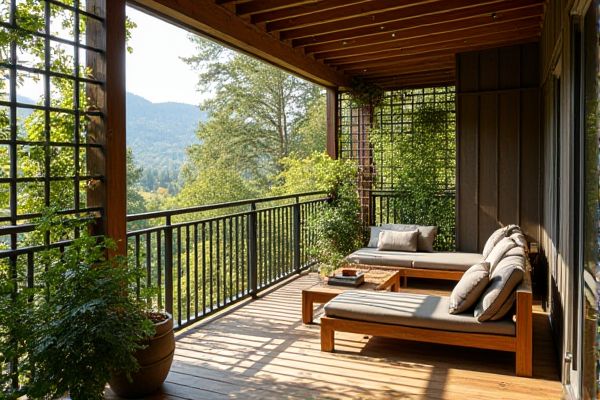
A balcony trellis provides a sturdy, decorative structure for climbing plants, enhancing both privacy and aesthetic appeal, while a privacy net offers a lightweight, quick-install solution primarily focused on blocking views and wind. To determine which option best suits your outdoor space and privacy needs, explore the detailed comparisons in the rest of the article.
Table of Comparison
| Feature | Balcony Trellis | Privacy Net |
|---|---|---|
| Material | Wood, metal, or plastic | Polyethylene or mesh fabric |
| Installation | Requires mounting on balcony frame or walls | Easy tie or clip attachment on rails or posts |
| Privacy Level | Moderate to high, depends on design | High, provides full visual blockage |
| Aesthetic Appeal | Decorative, often with climbing plants | Functional, less decorative |
| Durability | Long-lasting if maintained | Weather-resistant but may degrade over time |
| Cost | Higher initial investment | Affordable and budget-friendly |
| Wind Resistance | Stable, can block strong winds | Allows some airflow, less wind resistance |
| Maintenance | Periodic cleaning and repairs | Minimal maintenance |
Balcony Trellis vs Privacy Net: An Overview
Balcony trellises provide a sturdy and decorative solution for supporting climbing plants while enhancing outdoor aesthetics and privacy. Privacy nets offer a lightweight, flexible barrier that blocks visibility and wind but lack the structural support for vegetation growth. Your choice depends on whether you prioritize plant support and visual appeal or simple, effective screening.
Materials and Durability Comparison
Balcony trellises are commonly made from wood or metal, offering sturdy support for climbing plants and lasting several years with proper maintenance, while privacy nets are typically constructed from polyethylene or nylon, providing lightweight yet durable protection against wind and prying eyes. Your choice depends on the desired permanence and aesthetic; wooden trellises require periodic sealing to prevent rot, whereas privacy nets resist weathering and UV damage for extended outdoor use. Both materials optimize your balcony's functionality, but trellises offer structural strength, and nets deliver flexibility and easy installation.
Installation: Trellis vs Privacy Net
Balcony trellises typically require secure mounting to walls or railings using screws or brackets, ensuring stability for climbing plants and long-term use. Privacy nets offer a quicker, more flexible installation by tying or clipping directly onto balcony railings or frames without the need for drilling. Your choice depends on the desired permanence and ease of setup, as trellises favor sturdier, semi-permanent setups while privacy nets excel in temporary or adjustable privacy solutions.
Style and Aesthetic Appeal
Balcony trellises offer a structured and elegant design, enhancing vertical spaces with climbing plants that create a natural, green privacy barrier. Privacy nets provide a minimalist, subtle solution, often in neutral or solid colors, blending seamlessly into the background without obstructing views. Choosing between a trellis and a privacy net depends on whether you prefer a decorative, garden-inspired aesthetic or a simple, modern look for your balcony.
Maximizing Privacy: Which Option Works Best?
A balcony trellis offers a sturdy, decorative barrier that can support climbing plants, creating a natural privacy screen that blends seamlessly with outdoor aesthetics. Privacy nets provide an immediate, adjustable solution that blocks views with durable, weather-resistant fabric designed to withstand wind and sun exposure. Your choice depends on the desired balance between permanent coverage and flexible, quick installation for maximizing privacy on your balcony.
Plant Compatibility and Greenery Potential
Balcony trellises support climbing plants such as ivy, jasmine, and clematis, allowing vertical growth that enhances greenery and creates a natural, living screen. Privacy nets primarily serve as barriers and are less effective for plant attachment, limiting their ability to support lush vegetation. For maximizing greenery potential and plant compatibility, trellises offer a better solution by promoting healthy plant growth and aesthetic vertical gardens.
Weather Resistance and Maintenance
Balcony trellises, typically made from materials like wood or metal, offer strong weather resistance but may require periodic treatment or painting to prevent rust or rot. Privacy nets, often crafted from UV-resistant polyethylene or polypropylene, provide excellent durability against sun and rain with minimal maintenance needed. Your choice depends on whether you prefer a more structured, aesthetic option or a low-maintenance, flexible solution for outdoor privacy.
Cost Analysis: Budget Considerations
Balcony trellises generally offer a one-time investment with durable materials like wood or metal, often costing between $50 to $200 depending on size and design. Privacy nets tend to be more affordable upfront, usually ranging from $20 to $70, but may require replacement or repair more frequently due to exposure to weather conditions. Your budget should weigh the initial cost against long-term durability and maintenance expenses to determine the best value for your outdoor privacy needs.
Space Efficiency for Small Balconies
Balcony trellises maximize vertical space by allowing climbing plants to grow upward, making them highly space-efficient for small balconies. Privacy nets, while effective at blocking views, often require more horizontal space and can limit airflow. Choosing a trellis helps you maintain an open, green area without sacrificing precious balcony real estate.
Eco-Friendliness and Sustainability
Balcony trellises made from natural materials like bamboo or reclaimed wood offer a biodegradable, eco-friendly solution that supports plant growth and enhances urban biodiversity. Privacy nets often consist of synthetic fibers such as polyethylene, which can be less sustainable due to their non-biodegradable nature and potential microplastic pollution. Choosing a balcony trellis helps promote sustainability by using renewable resources and encouraging green spaces, aligning with your eco-conscious lifestyle.
 homyna.com
homyna.com